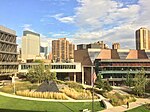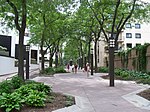Swinford Townhouses and Apartments

The Swinford Townhouses and Apartments are a development of townhouses and apartments in the Loring Park neighborhood of Minneapolis, Minnesota, United States. Both buildings are located in an area that surrounded the once-elegant Hawthorne Park. The townhomes were built first, in 1886 by Hodgson & Sons in the Second Empire style, using red brick, stone, and terra cotta. The apartments were designed in 1897 by locally prominent architect Harry Wild Jones, who preferred an eclectic style. The building is four stories tall, built of red brick and stone, and features a corner bay. They were built by Anthony Kelly, a nineteenth-century businessman who pioneered the wholesale grocery business in Minneapolis. Both the townhouses and the apartments were listed on the National Register of Historic Places in 1990. The apartments are now incorporated in the Laurel Village development.
Excerpt from the Wikipedia article Swinford Townhouses and Apartments (License: CC BY-SA 3.0, Authors, Images).Swinford Townhouses and Apartments
12th Street North, Minneapolis
Geographical coordinates (GPS) Address Nearby Places Show on map
Geographical coordinates (GPS)
| Latitude | Longitude |
|---|---|
| N 44.975277777778 ° | E -93.281666666667 ° |
Address
Alden Apartments
12th Street North
55403 Minneapolis
Minnesota, United States
Open on Google Maps







